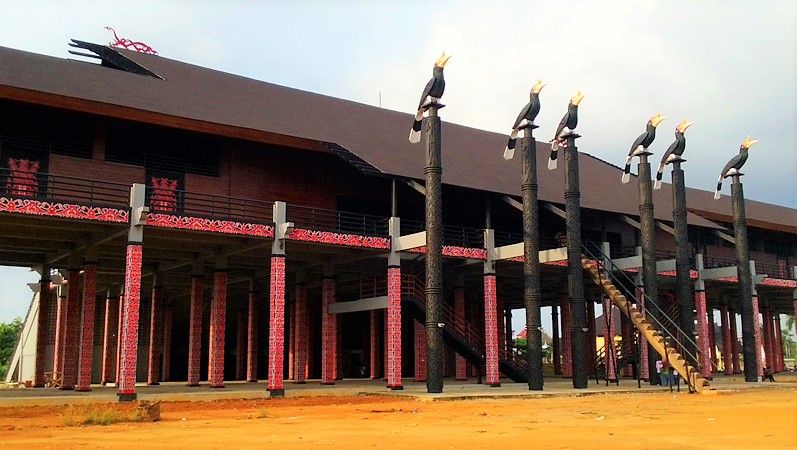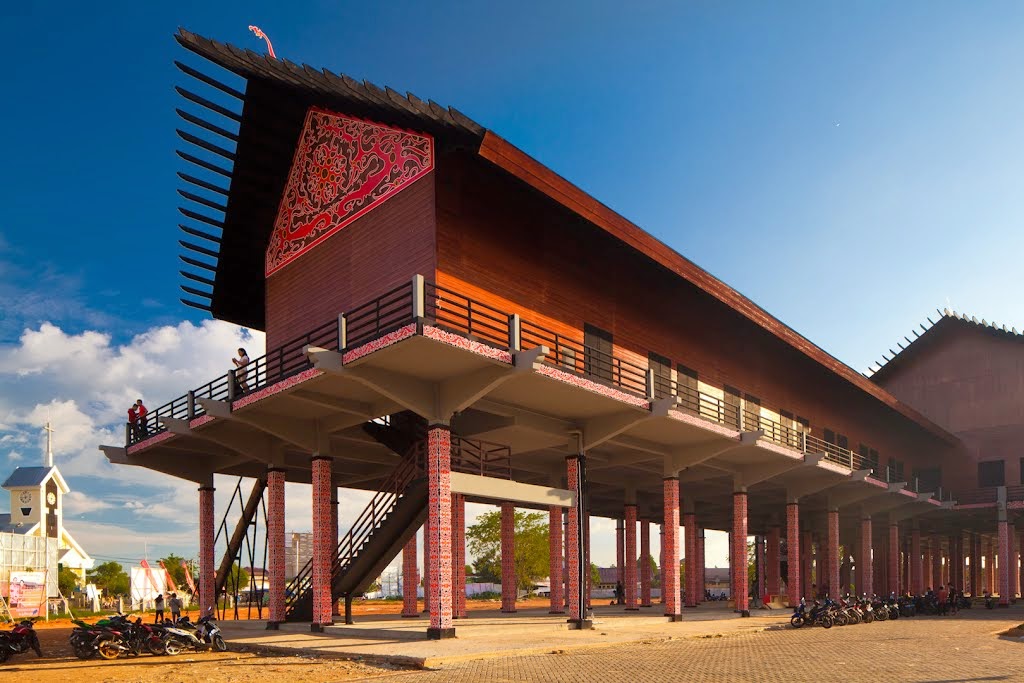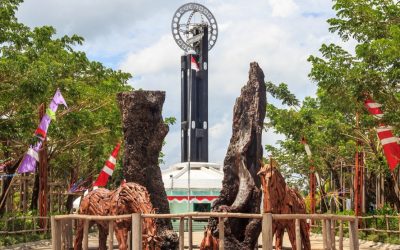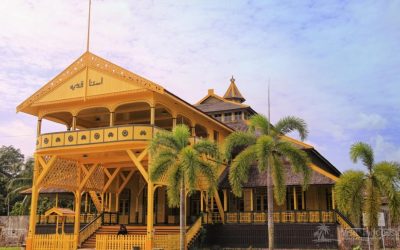Home / Batik Regions – Central Indonesia – Kalimantan Island – West Kalimantan / Betang Traditional House
Cultural Destination
Embrace the spirit of the place!
Betang Traditional House
Betang Traditional House of Dayak Community in Pontianak City (photo: Ricky Rahmanto)
(Photo: Indonesia Tourism)
Betang Traditional House
The Betang house is the traditional Dayak Great House, and it contains a lot of its spiritual and pragmatical expressions. Each directionality, material, decoration, and measurement conforms to a specific native religious principle. Betang House is the heart of the social and cultural life of the Dayak. In this huge building, whole clans live together harmoniously. All agreements are made for the common welfare and the welfare of each individual, and “togetherness” is considered to be the most important value.
Tourist Attractions in West Kalimantan
Equator Monument
As the main tower in Pontianak, the equatorial monument is crossed by a line that divides the
Pontianak City
The capital city of West Kalimantan that also known as the “Equator Zero”. Apart from this unique
Kadriah Royal Palace
This is the place if you want to see cultural assimilation through architecture. Located in East Pontianak,
West Kalimantan
Batik Motifs
Insang Ikan
Insang refers to the gills of the fish. This is a typical pattern of Malay ethnic who inhabits
Awan Berarak
Awan Berarak is a combination of Dayak motifs and Malay patterns. The word ‘Awan Berarak’ means the
Dayak Kamang
Kamang motif is generally found in the Dayak tribe shield because it is believed to
Discover
Indonesian
Batik
Motifs
Tifa Totobuang
The batik motifs illustrate Maluku’s traditional music instrument called
Parang Rusak
Another meaning behind this motif is an unconquerable spirit, symbolized by
Enggang Dayak
Local people beliefs that hornbills are an incarnation of the Commander of the Birds. It has supernatural
Ukir Sentani
The Ukir motif is a batik motif that is inspired by various traditional Sentani wood carvings
Tangerang Herang
Tangerang Herang motif is a symbol of Tangerang city. The Tangerang Herang batik motif consists of
Tikar Natuna
The Tikar Natuna motif is adapted from the traditional making of pandanus mats in
Mahkota Siger
Siger is the crown of a noblewoman in ancient time. It is a symbol of femininity, strength, and
Gedhog Kembang Waluh
a combination of Javanese cultural motif of the Majapahit kingdom (XII-XIV century) with
Kasih Tak Sampai
‘Kasih Tak Sampai’ is an idiom in the Indonesian language which refers to
Kaganga Tanah Rejang
If Batik Besurek combines Arabic calligraphy motifs, then the Kaganga batik takes
Sandeq
Sandeq Boat is a symbol of the maritime importance of the West Sulawesi region. The greatness of
Kuda Kupang
Horses symbolize wealth. It contains noble values of virtuous characters that bring
Gumin Tambun
Based on Hindu mythology, this motif symbolizes lucks, abundant wealth, and
Merak Ngeram
The hatching peacock motif has a very deep meaning which refers to the sacrifice and
Prada Papua
The word “Prada” in the Javanese-Indonesian dialect means a batik textile that
Durian Pecah
Broken Durian motifs depict the foundation of faith. The second half signifies the mastery of
Teguh Bersatu
This batik motif shows the strength of the people of Kupang. It also represents a sense of
Sido Mulyo
Sidomulyo is one of the classical motifs, which is specifically used for the bride’s costume in
Wirasat
Wirasat or divine inspiration is a gift from God. This inspiration is symbolized by
Raja Ampat
Raja Ampat motif represents the marine life at Raja Ampat archipelago in
Tengkawang Ampiek
With its many advantages, the Dayaks use this leaf in ritual ceremonies. This plant is a symbol of
Burung Bidadari
Bidadari birds are endemic birds in Halmahera. This motif represents an
Rumah Mamuju
the Batik motif illustrates the house of Mamuju King with the stairs, located on the left of the wooden stage house
Bintik Tujuh
The Bintik Tujuh (Seven Dots) motif has 7 white spots and green color gradation as
Daun Sirih
This motif illustrates betel leaves that are used by Lombok communities as traditional
Dayak Taghol
Dayak Taghol has a distinctive style of four curved lines and small dots. This motif represents
Tanah Liek
The word “Tanah Liek” refers to clay in Minang language. It is also known as
Besurek Rafflesia
The term “Basurek” refers to a textile that contains letters or inscriptions
Kawung
The Kawung motif was created by Sultan Agung Hanyokrokusumo (1593 – 1645) as a symbolic gift for
Daun Lada Hitam
The black pepper motif represents the main commodity of Bangka Belitung
Bultiya
The word ‘Bultiya’ is an acronym of the three major tribes in North Kalimantan, namely
Lok Baintan Floating Market
As you can imagine, the most authentic thing is that you can buy things and even
Paqbarre Allo
The word “Barre” means round and “Allo” means the sunlight. This motif is interpreted as
Gonggong Siput
Gonggong (Strombus Turturella) is one type of sea snail found around
Pattimura
Pattimura is the name of an Indonesian hero who fought against colonialism in
Bomba Mawar
This motif means sacred love for family, kingdom, and God; It also illustrates
Leuit Sijimat
This motif reflects the daily activities of the Baduy tribe in Banten. The main ornaments of batik motif consist of:
Wakatobi
It symbolizes the coastal beauty of the Wakatobi island and the symbol of Patra symbolizes
Jumputan Bintang
The word Jumputan means the tie-dye technique, while the word “Bintang” refers to
Gentala Arasy
Built as high as 80 meters, the tower also highlights the historical side of
Hiu Taliyasan
Indonesia is also home to the world’s largest fish, the whale shark (Rhincodon typus). Hiu Taliyasan refers to
Pala Salawaku
This motif illustrates the unique weapons of the Maluku region, namely
Karawo Pinang
Pinang refers to the Palm areca tree. This motif is considered as the original
Desa Na Tolu
The Desa Na Tolu characteristic pattern symbolizes the Batak philosophy of existence and
Pohon Hayat (Tree of Life)
The Batik motifs in Lampung are dominated by the acculturation of Buddhist and
Bekantan Pakis
This motif represents Pakis Haji (Polystichum setiferum), an endemic plant in
Gonggong Beruntun
This motif illustrates that a person should maintain a positive attitude and
Ikan tambal
The word “Ikan” refers to fish. The philosophical meaning of Ikan Tambal means is
Kerawang Tegak Aceh
The Vertical Upright (Kerawang Tegak) Motif symbolizes a person who has a strong
Keluak Daun Pakis
The word “Keluak” is a Minang language which means twisted or tangled. The Motif of
Pinawetengan
The Pinawetengan Batik pattern was taken from a prehistoric inscription in
Tongkonan
Toraja’s traditional house is called Tongkonan. Tongkonan is a place for
Tenun Bima
The motifs are adopted from Bima woven textile. This pattern has received a great
Besurek Rembulan
This batik illustrates praise for God who created the wonderful universe
Honai
The Honai is inspired by the traditional house of the Papuan community living in
Insang Ikan
Insang refers to the gills of the fish. This is a typical pattern of Malay ethnic who inhabits
Malinau Cultural Festival
You will witness a unique competition that might not be found other than in
Kain Cual
Cual textile tradition has existed since the 17th century. The word “Cual” refers to
Gorga Simeol-Meol
The Gorga Simeol-meol is a pattern of plant tendrils. it is regarded as a symbol of longevity and
Jupri Kembang Teh
Kembang Teh illustrates the tendrils of tea plants that grow in the highlands of
Sero Tangga
The Sero Tangga illustrates an endearing feeling and sacrifices of a person to fulfil
Biji Kopi
The coffee seeds motif illustrates the pride of local coffee specialities in
Tubo Kelapa
Coconut tree is a symbol of a good character and strong mentality. It illustrates the more success a person, the more
Bale Lumbu
This motif signifies the welfare of the ancient Sasak society. Bale also symbolizes the
Sekomandi
Its philosophical meaning is the eternal union which refers to a saying “until death do us part”
Dayak Kamang
Kamang motif is generally found in the Dayak tribe shield because it is believed to
Parang Seling
Parang Seling or “alternating daggers” is a royal batik motif. It is a feminine variant of
Singayaksa
The Singayaksa motif comes from the name of a place where Sultan Hasanuddin used to
Lontara
The Lontara script itself is a typical ancient script of Bugis and Makassar communities. History records that
Tampuk Manggis Sasirangan
The motif illustrates the philosophy of the mangosteen fruit, which is
Gigi Haruan Lidi
The Gigi Haruan Lidi motif is taken from the name of the cork fish and is a symbol of
Daun Simpor
This motif is inspired by the Simpor plant (Dillenia Suffruticosa) which is a typical
Kaharingan
The Kaharingan or ‘tree of life’ based on the Dayak tribes’ belief system. This tree symbolizes
Ake Patra
Ake is related to the divinity and the composition of the universe. It is a symbol of
Srimanganti
The name of the Srimanganti motif is derived from Palace’s hallway that connects to
Lipaq Sabe
Lipaq Saqbe contains a simple geometric classical motif with various flower decorations. This textile is





